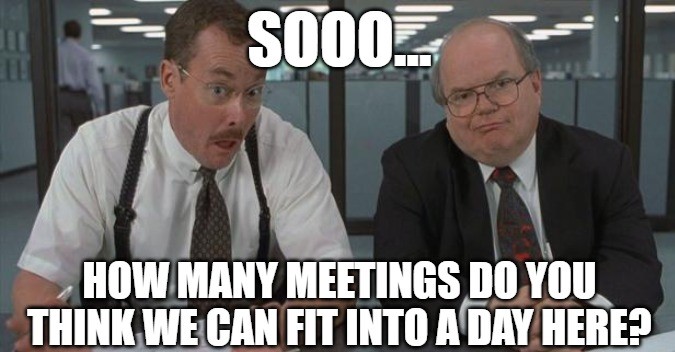When I shared my post about the value of ![]() writing weekly summaries months ago, I wasn’t sure how long it would be before I had a follow-up on it. Well, here’s the first follow-up on it!
writing weekly summaries months ago, I wasn’t sure how long it would be before I had a follow-up on it. Well, here’s the first follow-up on it!
An article that I was reading the other day triggered the inspiration for this post: For companies sticking with remote work, the rules for success are becoming clear. While I struggle with many articles written by people without direct experience, I want to highlight a quote from the article: “[Atlassian VP] Dean pushes employees to keep 50% of their day open for individual-focused productivity.” Atlassian, with a good idea? I had no idea they were players in the culture of remote work, but of course they are. Honestly, this is a brilliant marketing page.
This quote spoke to me, as 50% is exactly the target I held myself to in my first two years at Zillow. Why this target? Honestly, I made it up; it felt right for me as a TPM. Besides, I often take a 50/50 approach to things in life. There is power in indecision, and a 50/50 start is just the first step in a binary search of finding an optimal target 🤓. While you are free to adjust the target, perhaps for other roles or levels – just don’t let picking a target get in the way of you getting started.1
And what medium did you use to track this? Well, my weekly summary, of course! Check out ![]() the template I use for these summaries, and you’ll see an optional “Meeting Time” section.
the template I use for these summaries, and you’ll see an optional “Meeting Time” section.
So…how does one get started? I just looked at my calendar, and 🤢. Well, there’s good news! We all start here, and this is why this post is necessary. Even better news: you already did step 1.
Step 1: Audit Your Calendar
Starting this process means auditing your calendar over the past month and seeing how much time you spent in meetings both on a weekly basis and in an aggregate basis over the month. Was it relatively consistent week-to-week? Inconsistent? Did the inconsistency at least have merit to it, i.e., was there a good reason for it? If you audit another month, does this inconsistency consistently appear? 😅
Once you’ve done that, you have a sense of how much work you need to do to get to any target that you feel is reasonable. But it doesn’t need to be an overnight leap! In fact, any such overnight leap is guaranteed to be a temporary, one-off solution leading you right back to where you started in a month or two. Besides, you’re not ready to make any decisions yet; all you’ve done is practice something you’re now going to do at the end of every week for the foreseeable future (as you’ll learn in Step 5) 😂.
Step 2: Categorize Your Meetings
You now have an overall percent of your time spent in meetings, but not all meetings are created equal. Are you doing your weekly summaries like I suggested? As if so, you know what your priorities are. Now you should be to categorize your meetings to have a break out of how much of your meeting time is spent doing what.2 You should have a category for every priority, and then a few standard ones as well for things like interviews, team meetings, 1:1s, etc. You don’t need to go overboard with this; all told, you should have no more than 10 categories to keep this simple and useful, and you can always tag a meeting with multiple categories if needed (but I try to pick just one for ease).

Here’s a sample of what your calendar should look like – rainbow calendar 🌈!
Once you have done this, you should be able to track what percent of your meeting time goes to what every week. As oh, if it wasn’t clear – you’re going to start categorizing every meeting you send and receive from here on out. This way, you can see if you are spending a majority of your meeting time in accordance with your priorities. If you are writing weekly summaries – have I mentioned that you should be doing this? 🤣 – then you can see if you are spending most of your meeting time on your top priorities. When you’re not – because if you are just starting this, you likely aren’t – you can then start adjusting for future weeks.
Step 3: Start Replying to Meetings with “Tentative” or “Decline”
Do you check whether you’re required or optional on meetings before you accept? Because you should. I reply to all meetings where I am optional with tentative by default, and I rarely attend. If the meeting has a solid agenda shared in advance and it seems like I can provide value, maybe I’ll attend live. However, often I just care about seeing the notes shared after-the-fact; why attend a 30+ minute meeting when I can just read for 5 minutes instead? That’s a good trade! Start making this trade, again and again, and watch the time add up.
But what if people don’t use the optional vs required tag on meetings? First, lead by example – this feature is supported by both Outlook and Google Calendar, so you have no excuse not to do it. If you find people need help realizing you are doing this, I often lead my meeting agendas shared in the invite with “Please note optional vs required.” Leave it up to attendees to manage their own time.
Second, you can start replying tentative to meetings where you believe you are not required with text saying “It seems like I am not needed live for this. If you disagree, please let me know and I will attend.” If preferred, you can flip to asking the meeting organizer for their opinion, but I find the former assertive style works better (and you still give the meeting organizer the ability to request your presence). This tactic is especially useful for meetings that don’t have clear agendas laid out in advance.
What if I am required? Do I always accept? No. You should if you can, but be reasonable on yourself. You don’t just want to attend meetings, but provide value and have them be a good use of your time. I find I can either have meetings start early in a day or end late, but not both. Find your own rules and stick to them!
Step 4: No Meeting Friday
OK, I am sure you’ve heard of the no meeting day trick, and you likely rolling your eyes right now 🙄 because this meme feels accurate:

But hear me out – I didn’t just say “pick a no meeting day and hold to it.” I said “No Meeting Friday.” Why Friday? Which I will answer in the best and worst way: why not Friday?
You spend all week meeting about a problem, working on the problem, getting in the rhythm, and maybe even solving the problem. Why would you interrupt this flow midweek?
Or think about it this way: you can choose one day to crank out all of your work for the week, be done, and then go enjoy your afternoon. Which day do you choose? Friday, right? There isn’t even a close second.
Or think about it this way: you need time to write a weekly summary and audit your calendar for the week. Which day do you choose? Heh, I think you get the point – ![]() Friday.
Friday.
No Meeting Fridays actually work because they’re desirable. You are incentivized to not schedule meetings on Fridays, because you don’t want the meeting. Yeah, setup a recurring time block every Friday marking you as tentative with no end date. But most importantly, don’t violate your own rule unless you want to! I personally find I keep most of my Fridays limited to one hour of meetings or less, and the meetings I do have are generally more casual and fun by design.
To be clear, No Meeting Friday doesn’t mean four day work weeks (sorry). Rather, all those meetings you had earlier in the week where you signed up for action items? Now is your dedicated time to do them, even the ones that require deep work and thought. There are lots of other posts about the benefits of No Meeting Days, but I particularly like this one for its meme alone 😂.
Step 5: Audit Your Calendar Again at the End of Every Week
Congratulations; now you’re in the rinse & repeat stage! You can keep this audit private or not, but I fed this audit into my weekly summaries directly. I did this by just having a specific sub bullet of the amount of time I spent in meetings related to the priority. So, if my top priority had two hours of meetings, but my fifth had 10, then either there was a clear discrepancy that I knew I needed to address or there was a one-off event that would inform my update for the week. Thus, the situation is either improved or explained! Not so bad, eh?
Admittedly, this is different than what I have in ![]() the template I shared for weekly summaries. I eventually graduated to just looking at my overall time spent in meetings, which is the optional section you see here. But you shouldn’t follow my template too strictly; it’s just a template, after all. Do what you need to take control of your calendar!
the template I shared for weekly summaries. I eventually graduated to just looking at my overall time spent in meetings, which is the optional section you see here. But you shouldn’t follow my template too strictly; it’s just a template, after all. Do what you need to take control of your calendar!
Conclusion
If you do these steps for at least one quarter, you’ll make a habit out of it. It took me a little over a year to no longer need such formality of this tracking, but it’s now been ingrained in me. I still categorize every meeting, so if I ever think “where did my time go?” I know the answer with a quick glance of my calendar. Make a habit of it, and you just might get folk asking you on a weekly basis “how is your calendar so open?” The dream, right? So what’s stopping you?
Footnotes
- I admit, manager roles likely need a higher target if they are doing weekly 1:1s with their direct reports, and they should be doing weekly 1:1s with their direct reports 🙃! I still argue the target should be no higher than 75%. ↩︎
- See here for instructions on how to categorize meetings in Outlook. See here for instructions in Google Calendar. ↩︎



2 Comments
Leave your reply.